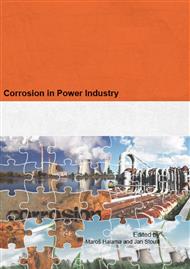p.31
p.41
p.49
p.59
p.63
p.67
p.77
p.83
p.91
Influence of Temperature on the Electrochemical Characteristics of Ti-6Al-4V
Abstract:
Titanium is not only the most widely used biomaterial for medical implants, but with its very good mechanical properties, corrosion resistance and low density is also applicated in many sectors of industry (aerospace, military, aviation, machinery, energetics, chemicals, etc.). In this paper it is described the influence of temperature on the electrochemical characteristics of Ti-6Al-4V alloy. The surface was mechanically grinded and polished by chemical-mechanical process. Basic electrochemical characteristics were determined by potentiodynamic tests in 0.1M NaCl solution at different temperatures. The obtained results were analysed by the Tafel-extrapolation method. Finally, a modified Arrhenius relation was used for determination of activation energy. The activation energy of grinded and chemical-mechanical polished surface is nearly three times higher than activation energy of only grinded surface.
Info:
Periodical:
Pages:
77-82
Citation:
Online since:
December 2014
Authors:
Price:
Сopyright:
© 2015 Trans Tech Publications Ltd. All Rights Reserved
Share:
Citation:


